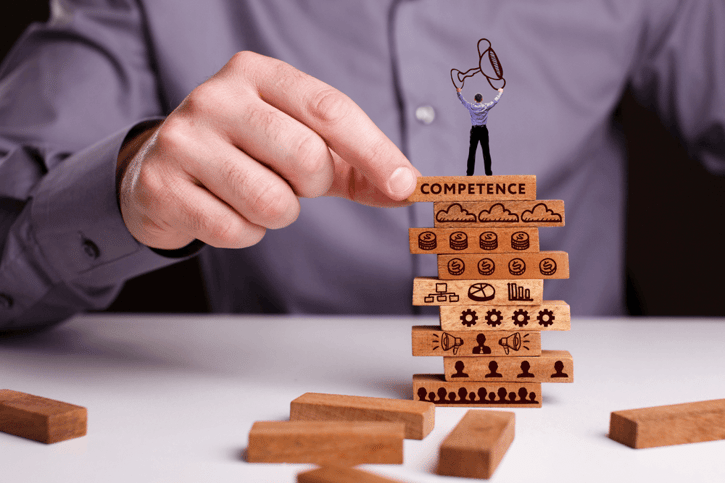In this article, we distinguish between job descriptions and competency models, underscoring the enhanced value the latter brings to organizations.
What is a competency model?
A competency model is essentially a blueprint that outlines the specific skills, knowledge, attitudes, and behaviors needed for successful job performance within an organization. It defines what "good" looks like in a particular role. This framework can be applied to various positions or departments, depending on your needs.
What is a competency?
A competency itself is a combination of knowledge, skills, and behaviors (KSBs) that an employee needs to excel in their role. It's not just about technical skills; it also encompasses things like communication, problem-solving, and teamwork. Competencies can be categorized as hard skills (technical abilities) or soft skills (interpersonal qualities).
What is the purpose of a competency model?
Competency models serve several key purposes in HR and talent management:
- Recruitment and Hiring: The model provides a clear picture of the ideal candidate, allowing you to target qualified individuals with the right skillset and behaviors. You can tailor your job descriptions, interview questions, and selection processes to assess these competencies.
- Training and Development: By identifying the desired competencies, you can create targeted training programs to bridge any skill gaps and develop your workforce. This ensures your employees have the capabilities to achieve their goals and organizational objectives.
- Performance Management: Competency models provide a structured framework for performance evaluations. Both managers and employees have a clear understanding of the expectations and can set goals based on the defined competencies. Performance reviews can then be conducted based on these criteria, ensuring a fair and consistent process.
- Succession Planning: Competency models help identify high-potential employees who possess the necessary skills and behaviors for future leadership roles. This allows you to develop future leaders from within the organization.
Overall, competency models are valuable tools for HR professionals and employers to build a strong, successful workforce aligned with your organizational goals.
.png?width=323&height=124&name=img-16%20(1).png)
Employee scheduling and Time-tracking software!
What are the benefits of using a competency model?
A competency survey by the Society for Human Resource Management (SHRM) revealed that organizations with well-defined competency models are more likely to attain tremendous performance success. An astounding 93% of 500 C-suite executives labeled competency models vital in their organization’s journey toward peak productivity.
Here are some of the advantages that organizations can derive from deploying a competency model:
- Establish a clear path to employee success that aligns with organizational objectives and strategies.
- With this tool, HR can gain a strong knowledge of all employee skills and abilities for more efficient workforce planning.
- With the help of HR and training, pinpointing learning & development needs is more precise than ever.
- Empowering employees to own the skills and behaviors necessary for their roles allows them to take charge of their career development.
- Organizations can use strategic planning to identify and develop the future abilities needed for success by keeping track of employees' existing skills.
- Creating an equitable, uniform system for assessing performance.
The types of competencies that make up the model

The competencies necessary for various professional roles vary significantly and depend on the particular requirements of the job. For instance, someone in a restaurant serving role would require an entirely different set of skills than an accountant's. Consequently, there is no universal pre-defined list that applies to all jobs out there.
To gain a better comprehension of the knowledge that may be incorporated, competencies can easily be divided into several helpful categories, including:
1. Core competencies
Every company holds a distinct set of core competencies that each employee must fulfill. These baseline skills are determined by the values, philosophy, and goals unique to each organization and can range from communication abilities to teamwork orientation. Given that most job roles involve working with other people in some capacity, even these fundamental characteristics have become essential in workplace environments.
The purpose of this organization is reflected in its core competencies, which are defined by the strength and creativity that set it apart from competitors. For instance, if an organization specializes in global parcel delivery, then logistics would be its main competence. Taking it a step further, an employee's job within such an institution; may have a particular core competency focused on timely customer package receipt.
2. Functional competencies
Every position has unique abilities and activities essential for successful performance. Think of a restaurant waiter: one competency they must have is the talent to address customer worries deftly. An accountant, on the other hand, needs superb analytical skills to create reports based on specific financial data points. These requirements are known as functional competencies - specific job-related talents which vary from role to role.
To become an exceptional employee, one must possess the functional competencies needed to succeed. These capabilities define the behaviors and abilities to be demonstrated for peak performance.
3. Leadership competencies
When discussing competencies for managerial or supervisor roles, leadership capabilities are typically the first to come to mind. However, these capacities can be applied to any job requiring an individual to lead others - from decision-making skills and behaviors to other essential qualities.
Example of a competency
The structure of a competency model for any given job varies depending on the specific organization and profession, as there is no standardized or required format. Often, organizations will have their distinctive templates for competency models.
The Society for Human Resource Management (SHRM) provides a best practice for formulating competencies by outlining the information that should ideally be included in a specific competency:
Best Practice:
- Title – The competency's name
- Definition – A comprehensive description of the competency
- Sub-competencies – Fundamental skills and behaviors required
- Behaviors – Actions that demonstrate the highest level of proficiency
- Proficiency Standards – Skill standards that reflect job-specific requirements and correspond to four stages of career development (early, mid-level, senior, executive)
Competency Example:
- Title: Cultivate customer relationships
- Definition: In the context of the sales process, establishing long-lasting relationships with customers through interactions is essential to the role.
- Sub-competencies: Effective communication with customers
- Behaviors: Emotional intelligence
- Proficiency Standards: Recognize customer concerns and propose strategies to address those concerns.
How to develop effective competency models

1. Determine what kind of process works for your organization
Developing the right competencies for a role takes substantial time and research; it is essential to understand what each position requires. With today's quickly evolving business environment, an efficient and comprehensive development method could benefit many organizations. Additionally, flexible models can help accommodate any future changes that come up as well.
2. Research available competency information
Crafting competencies encompass more than issuing broad statements regarding a job title's duties. These functional aptitudes must reflect what stellar performance looks like, not just the minimum abilities necessary for "satisfactory" performance.
When preparing to fill a role, it is essential to identify and use previously established competencies for similar roles and associated job documentation, resources, and organizational core competencies. This will provide a useful framework upon which you can build.
3. Interview relevant business units and executives
Uncovering the exact competencies required for a role begins with interviewing appropriate stakeholders. Executives can reveal core competencies to mirror the organization's principles, goals, and values. On top of that, speaking with managers and high-performers from relevant departments will uncover the abilities and habits needed for optimum performance in each job. During these interviews, center around which skillsets and behavior make up an exceptional worker in this role.
4. Establish the core competencies
Core competencies must be established to integrate into the organization's culture and philosophy. These should mirror the behavior and abilities necessary for employees to be successful in their roles. To ensure this occurs effectively, executives and other key organizational stakeholders must participate in research interviews to provide insight into how staff members need to act accordingly.
5. Establish job-specific competencies
To best determine the job-specific competencies required, departmental managers and top performers should be thoroughly researched regarding what distinct role skills and behaviors are necessary for successful performance. What knowledge must they possess? What actions do they need to take? Answering these questions will ensure that accurate requirements of each position can be set out accordingly.
6. Establish leadership competencies where needed
When devising management-related competencies, it is essential to recognize that the individuals should already be aware of the organization's core competencies. Focus instead on identifying exclusive leadership attributes and skills. These can be identified by the executive and senior management at the point of research.
7. Finalize the competency list
Structure the results in a way that is realistic and specific. If you narrow down competencies too much, it could risk deterring possible applicants or lead to an overwhelming number of candidates that may not be qualified for the job; if, on the other hand, your list is too broad or lacks specificity, employees won't have clear goals to strive towards. Hence, find equilibrium between both ends – target perfect matches for the position while still inviting enough not to lose out on potential talent.
Confirming the competency list with all parties involved, from executives and management down, is essential. By doing this we can guarantee that everyone's needs are considered and met accordingly. Approving these competencies will ensure the successful completion of our organizational goals.

.png?width=323&height=124&name=img-16%20(1).png)







